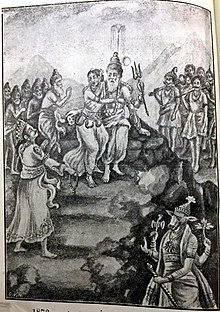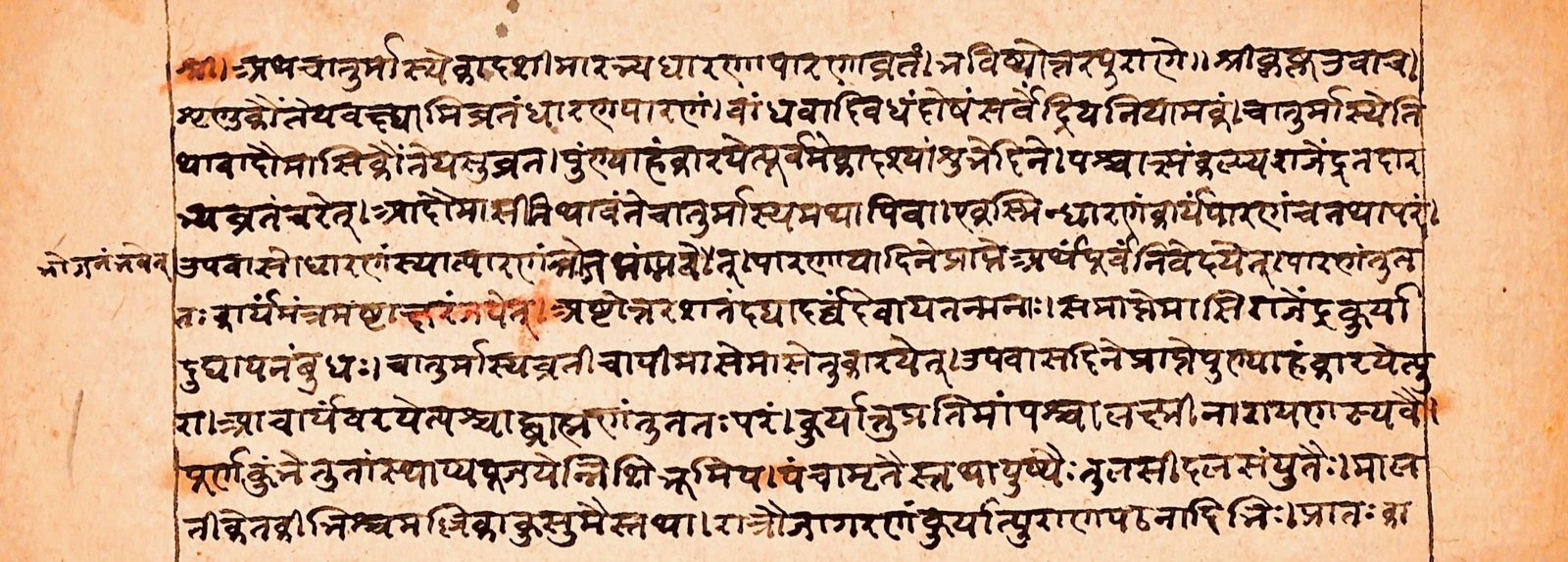From Cosmic Deluge to Divine Ethics: The Rich Tapestry of Myths and Moral Teachings in the Manava Purana

The Manava Purana, a significant yet lesser-known text within the vast corpus of Hindu scriptures, offers profound insights into the spiritual and cultural heritage of ancient India. This Purana is one of the eighteen Upapuranas, serving as a supplementary text to the major Puranas in Hindu literature. It is particularly focused on the duties, responsibilities, and ethical conduct of human beings, drawing from the ancient law codes attributed to Manu, the legendary lawgiver in Hindu tradition. The Manava Purana is an essential resource for understanding the principles of dharma as they apply to various aspects of human life, including social, moral, and spiritual dimensions. Its teachings are aimed at guiding individuals toward a righteous and fulfilling life.

The authorship and precise date of the Manava Purana’s composition are not definitively known, similar to many ancient Indian texts. However, it is generally believed to have been written between the 5th and 10th centuries CE. This period was characterized by the codification and formalization of dharma-shastras (legal and ethical texts), reflecting the evolving social and cultural norms of Indian society. The Manava Purana, like other Puranas, was likely composed to reinforce and elucidate the principles of dharma, providing guidance to individuals in their daily lives and spiritual practices.
Mythology
The mythology within the Manava Purana is rich and varied, encompassing tales of gods, demons, sages, and humans. These narratives serve not only as religious teachings but also as reflections of the cultural and moral values of ancient Indian society. Central to its narrative is the figure of Manu, who is considered the first human and the archetypal king. Manu is revered as the progenitor of mankind and the lawgiver whose codes of conduct form the foundation of human civilization.
According to this Purana, Manu was chosen by the gods to lead humanity after a great deluge, a story that echoes the flood myths found in many other cultures, including the Biblical account of Noah’s Ark and the Mesopotamian Epic of Gilgamesh. This story is emblematic of the recurring themes in Hindu mythology, where cosmic destruction and renewal are part of a never-ending cycle.
In one of the most famous stories, Manu is warned by the god Vishnu, who takes the form of a small fish. As the fish grows larger, Manu realizes its divine nature. Vishnu informs Manu of the impending flood that would destroy the world. Following Vishnu’s instructions, Manu builds a massive boat and gathers seeds of all plants, pairs of all animals, and the seven great sages (Saptarishi) to ensure the survival and regeneration of life on earth. When the flood waters recede, Manu performs a grand sacrifice, and from the offerings, the new world is created.
This story symbolizes the cyclical nature of time, where the universe undergoes periods of creation, preservation, and destruction. The narrative also emphasizes the themes of divine guidance and human responsibility, illustrating how the gods intervene in times of crisis to preserve cosmic order, but ultimately, it is up to humans to follow divine guidance and uphold dharma.
Moreover, this Purana contains other mythological tales that highlight the virtues of righteousness, devotion, and the power of penance. For instance, it recounts the story of a king who, through severe penance and unwavering devotion, earns the favour of the gods and brings prosperity to his kingdom. These stories serve as moral allegories, teaching the importance of adhering to one’s duties and the consequences of straying from the path of righteousness.
The text also delves into the battles between gods and demons, representing the eternal struggle between good and evil. These cosmic battles, where deities like Vishnu and Shiva vanquish formidable demons, are metaphors for the inner battles humans face against their own negative tendencies. The victories of the gods over the demons reinforce the belief in the ultimate triumph of good over evil and the protection offered by the divine to those who live virtuously.
The mythology of this Purana, with its rich symbolism and profound moral lessons, not only provides a spiritual framework for understanding the universe but also offers guidance for leading a life in harmony with cosmic principles. Through these stories, the Purana conveys timeless truths about the human condition, the nature of the divine, and the importance of living in accordance with dharma.

Gunas
In the Manava Purana, the concept of gunas—the three fundamental qualities that constitute the universe—is integral to its philosophical teachings. These gunas are sattva (purity and harmony), rajas (passion and activity), and tamas (ignorance and inertia). The text emphasizes the importance of cultivating sattva to achieve spiritual growth and harmony in life.
It teaches that the balance of these gunas within an individual determines their thoughts, actions, and ultimately, their destiny. It encourages the pursuit of knowledge, righteousness, and devotion as a means to elevate sattva and transcend the lower qualities of rajas and tamas. This framework of gunas is not only a key aspect of the Manava Purana’s spiritual teachings but also a guiding principle for ethical and moral behaviour.
Deities
The deities in the Manava Purana are portrayed with deep reverence, each embodying a different aspect of the divine. Vishnu, in particular, holds a central place as the preserver of the universe. His incarnations, especially as the fish Matsya in the flood narrative, illustrate his role in protecting the world and guiding humanity through the cycles of creation and destruction.
Shiva, the destroyer, is depicted as both a fearsome and benevolent figure. The Purana acknowledges his power to bring about the end of the world, but also his role in purifying and regenerating the cosmos. Brahma, the creator, is respected as the source of all life, though his prominence in the text is often overshadowed by the more active roles of Vishnu and Shiva.
In addition to these principal deities, the Purana also pays homage to a wide range of other gods and goddesses, including Lakshmi, Saraswati, and Parvati, who embody different energies and principles within the Hindu pantheon.

Writers
The composition of the Manava Purana is traditionally attributed to various sages and scholars who compiled and transmitted its teachings over generations. While Manu is credited as the primary sage behind the text, the exact identity of its authors is shrouded in the mists of time. It is likely that the Purana, like many other ancient texts, was a collective work, evolving through oral traditions before being committed to writing.
The text reflects the wisdom of multiple contributors, each adding layers of meaning and interpretation to its teachings. The influence of the Manusmriti is evident, as both texts share common themes and principles, particularly concerning dharma (righteousness) and the duties of individuals in society.
Verses
The verses of the Manava Purana are composed in classical Sanskrit, adhering to the traditional meters and styles of ancient Indian poetry. These verses are not only a vehicle for transmitting the text’s teachings but also a work of literary art, rich with symbolism, metaphors, and allegories.
One of the central themes in the verses is the concept of dharma— the moral and ethical duties that sustain the order of the universe. The Purana expounds on the different types of dharma relevant to various stages of life and social roles, guiding how to live a virtuous and meaningful life.
The verses also explore the nature of the soul (atman), the concept of karma, and the paths to liberation (moksha), offering a comprehensive guide to spiritual practice and enlightenment.
Worship
The Manava Purana outlines various rituals and practices for worshipping the gods, emphasizing the importance of devotion (bhakti) and the observance of sacred rites. The text provides detailed instructions on performing sacrifices (yajnas), reciting mantras, and making offerings, all of which are considered essential for maintaining cosmic harmony and gaining divine favour.
The Purana also highlights the significance of pilgrimages, festivals, and temple worship as means of connecting with the divine and purifying the mind and body. These practices are seen not just as religious duties but as ways to cultivate spiritual virtues and attain higher states of consciousness.
Legacy
The legacy of the Manava Purana lies in its enduring influence on Hindu thought and practice. Although it may not be as widely studied as some other Puranas, its teachings on dharma, the gunas, and the nature of the soul have left a lasting impact on the spiritual and philosophical traditions of India.
The Purana’s emphasis on the cyclical nature of time and the recurring themes of creation, preservation, and destruction have also shaped the Hindu worldview, reinforcing the belief in the eternal continuity of the universe.
Scientific Learnings
The Manava Purana, like many ancient texts, contains knowledge that can be interpreted through the lens of modern science. Its understanding of the gunas as fundamental qualities that govern the behaviour of matter and energy can be seen as an early exploration of concepts similar to those found in physics and psychology.
The Purana’s cyclical view of time and the universe resonates with modern cosmological theories, which also suggest that the universe undergoes cycles of expansion and contraction. Additionally, the text’s emphasis on the interconnectedness of all life forms and the balance of natural forces aligns with contemporary ecological and environmental principles.
Conclusion
The Manava Purana, with its rich tapestry of mythology, philosophy, and spiritual teachings, offers a unique window into the ancient wisdom of India. Its teachings on dharma, the gunas, and the nature of the divine continue to inspire and guide seekers on their spiritual journeys. While it may not be as prominent as some other Puranas, its contributions to the understanding of Hindu philosophy and practice are profound, making it a valuable text in the vast library of Indian scriptures.


